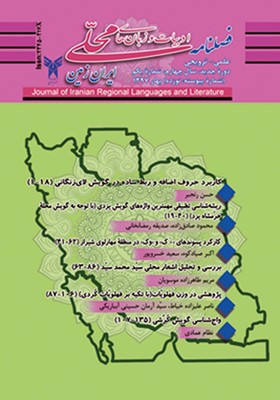واج شناسی گویش کُرُشی
محورهای موضوعی : زبان، گویش ها و ادبیات مناطق مرکزی (اصفهان، فارس، تهران، سمنان و غیره))
1 - استادیار گروه زبان شناسی دانشگاه آزاد اسلامی واحد مرودشت
کلید واژه: گویش, زبانهای ایرانی, واجشناسی, بلوچی, کُرُش,
چکیده مقاله :
هدف ازاین مقاله، بررسی و توصیف نظام واجی گویش کُرُشی در استان فارس است. گویش کُرُشی به شاخه غربی-شمالی زبانهای ایرانی نو تعلق دارد. کُرُش نام قومی است که بیشتر در استانهای فارس و هرمزگان پراکندهاند. افزون بر این، کُرُش نام تیرهای از طایفه کشکولی بزرگ است که در سدههای پیشین به ایل قشقایی پیوسته است. با این حال، زبانشان ترکی نیست، بلکه گویشی از زبان بلوچی است. در این پژوهش، نخست همخوانها و واکهها معرفی و بررسی میشوند. سپس به واجآرایی، ساخت هجا، فرایندهای واجی مانند همگونی، ناهمگونی، ابدال، افزایش، کاهش پرداخته میشود. با توجه به بررسی و سنجشهای واجی، این گویش دارای 25 همخوان (p, b, t, d, k, g, q, ʔ, f, v, s, z , š, ž ,x , ,h ,č ,ǰ , m ,n , ŋ, l ,r , ř, y) و 8 واکه (â, a, e, ē, i, o, ō, u) و 5 واکه مرکب (ey, ow, ay, ây, uy) است. از ویژگیهای واجی در همخوانها و واکههای این گویش وجود همخوانهای /ŋ/ و /ř/ و واکههای /ō/ و /ē/ است. /ŋ/ همخوانی است که واجگاه آن نرمکامی است و شیوه تولید آن خیشومی است. /ř/ برخلاف /r/ چندزنشی است و با وجود بسامد اندک آن در این گویش، متمایزدهنده معنی است. در گویش کُرُشی، دو واکه /ō/ و /ē/ به ترتیب بستهتر از دو واکه /o/ و /e/ است. ساخت هجا در این گویش، همچون فارسی رسمی CV(C)(C) است.
Korosh is a tribe mainly dispersed across the provinces of Fars and Hormozgan in Iran. The objective of this article is to study and describe the phonemic system of Koroshi dialect in the province of Fars. Koroshi is a dialect of Baluchi language which belongs to the northwestern branch of New Iranian languages. The article introduces and explains the consonants and vowels of the dialect and then proceeds to examine the phoneme arrangement, syllable structure, phonemic processes such as assimilation, dissimilation, alteration, epenthesis and deletion. Considering the analysis and evaluation of the phonemes conducted above, this dialect has twenty-five consonants (p, b, t, d, k, g, Ɂ, f, v, s, z, š, ž, x, γ, h, č, ǰ, m, n, ŋ, l, r, ř, y), eight vowels (i, e, ē, a, â, o, ō, u) and five diphthongs (ey, ay, ow, ây, uy). The phoneme /ř/ is a trill, double flap, alveolar and voiced consonant versus the phoneme /r/ which is a trill, single flap, alveolar and voiced. Notwithstanding, the consonant /ř/ has low frequency, it makes a phonemic distinction and has a minimal pair with /r/. In addition, the nasal consonant /ŋ/ is a nasal and velar phoneme which it does not appear in onsets. The syllable structure in this dialect, like standard Persian, is CV(C)(C). Nezam Emadi nezamemadi@gmail.com Assistant professor of linguistics department, Marvdasht branch, Islamic Azad University, Marvdasht, Iran
- افشار سیستانی، ایرج، (1371)، بلوچستان و تمدن دیرینۀ آن، تهران: سازمان چاپ و انتشارات وزارت فرهنگ.
- --------------، (1380)، عشایر و طوایف سیستان و بلوچستان، تهران: موسسه انتشاراتی و آموزشی نسل دانش.
- بیجن خان، محمود، (1384)، واج شناسی نظریه بهینگی، تهران: سمت.
- ثمره، یدالله (1378)، آواشناسی زبان فارسی(ویرایش دوم)، تهران: مرکز نشر دانشگاهی.
- حق شناس، علیمحمد، (1376)، آواشناسی، چ 5، تهران: آگاه.
- زمردیان، رضا، (1379)، راهنمای گردآوری و توصیف گویش ها، مشهد: دانشگاه فردوسی.
- سربازی، عبدالصمد، (1378)، بلوچ و بلوچستان، ترجمه محمدسلیم آزاد، سنندج: کردستان.
- سرشماری اجتماعی-اقتصادی عشایر کوچنده 1387، (1388)، تهران: مرکز آمار ایران و دفتر ریاست امور بین الملل و روابط عمومی.
- عمادی، نظام، (1384)، گویش کروش (کُرُش)، شیراز: آوند اندیشه.
- کرزن، جورج ناتانیل، (1380)، ایران و قضیه ایران، تهران: علمی و فرهنگی.
- کیانی، منوچهر، (1376)، سیه چادرها: تحقیقی در زندگی مردم ایل قشقایی، چ2،شیراز: کیان نشر.
- مشکوۀالدینی، مهدی، (1377)، ساخت آوایی زبان، چ 4، مشهد: دانشگاه فردوسی.
- ناصح، ذبیحالله، (1345)، بلوچستان، تهران: ابن سینا.
- نجفی، ابوالحسن، (1376)، مبانی زبانشناسی و کاربرد آن در زبان فارسی، چ 5 ، تهران: نیلوفر.
- یارمحمدی، لطف اله، (1364)، درآمدی بر آوشناسی، تهران: مرکز نشر دانشگاهی.
- Carr, P, (2008), A Glossary of Phonology, Edinburg: Edinburg University Press.
- Crystal, D, (2008), A Dictionary of Linguistics and Phonetics (6th ed.), UK: Blackwell Publishing.
- Glatzer, B, (1998), “Is Afghanistan on the Brink of Ethnic and Tribal Distintegration?” In William Maley (ed.), Fundementalism Reborn? Afghanistan and the Taliban. (167-181), London: Hurst & Company.
- Janata, A, (1990), “Afghanistan, the Ethnic Dimension”. In Ewan W. Anderson et al (eds.), the Cultural Basis of Afghan Nationaliam (1-24), London: Printer Publishers.
- Jensen, T. J, (2008), Principles of Generative Phonology: An Introduction,
Amesterdam: John Benjamins Publishing.
- Mathewes, P.H, (2007), The Concice Oxford Dictionary of Linguistics (2nd ed.), New York: Oxford University Press.
- Nijjar, B.S, (2008), Origins and History of Jats and Other Allied Nomadic Tribes of India 900 B.C- 1947 A.D, NewDelhi: Atlantic.
- Oberling, P, (1974), The Qashqai Nomads of Fars, The Hague: Mouton.
- Richards, J. C & Schmidt, Richard. W, (2013), Longman Dictionary of Language Teaching and Applied Linguistics (4th ed.), New York: Routledge.
- Rzehak, L, (2012), “Ethnic Monitories in Search of Political Consolidation”, In Bashir, Sh & Crews, R. D (eds.), Under the Drones: Modern Lives in the Afghanistan-Pakistan Borderlands (136-151), Massachusetts: Harvard University Press.
- Rose, H.A, (1997), A Glossary of Tribes and Castes of the Punjab and North-West Frontier Province, New Delhi: Nirmal Publishers and Distributors.
- Smit, A. B, (2003), Articulation and Phonology Resource Guide for School-Age Children and Adults, New York: Thomson.
_||_
